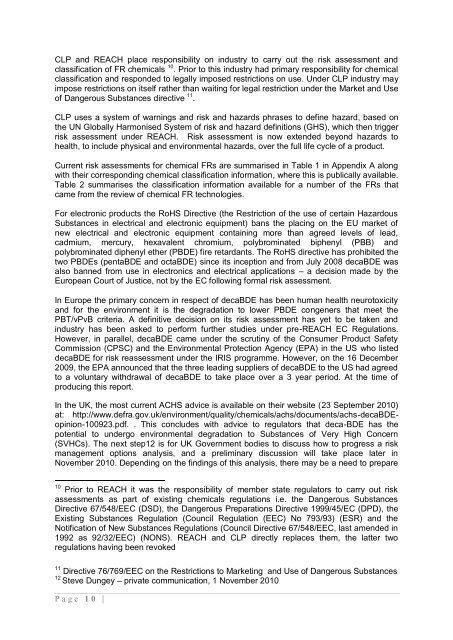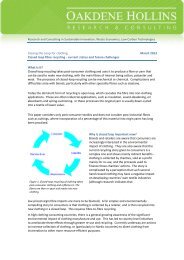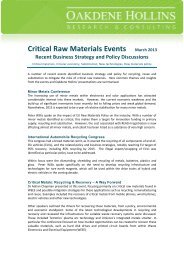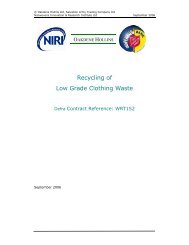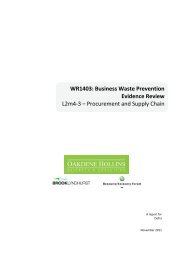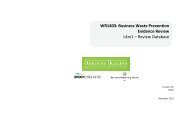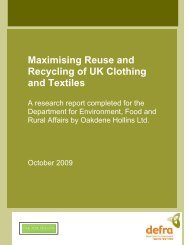Fire Retardant Technologies: safe products with ... - Oakdene Hollins
Fire Retardant Technologies: safe products with ... - Oakdene Hollins
Fire Retardant Technologies: safe products with ... - Oakdene Hollins
- No tags were found...
You also want an ePaper? Increase the reach of your titles
YUMPU automatically turns print PDFs into web optimized ePapers that Google loves.
CLP and REACH place responsibility on industry to carry out the risk assessment andclassification of FR chemicals 10 . Prior to this industry had primary responsibility for chemicalclassification and responded to legally imposed restrictions on use. Under CLP industry mayimpose restrictions on itself rather than waiting for legal restriction under the Market and Useof Dangerous Substances directive 11 .CLP uses a system of warnings and risk and hazards phrases to define hazard, based onthe UN Globally Harmonised System of risk and hazard definitions (GHS), which then triggerrisk assessment under REACH. Risk assessment is now extended beyond hazards tohealth, to include physical and environmental hazards, over the full life cycle of a product.Current risk assessments for chemical FRs are summarised in Table 1 in Appendix A along<strong>with</strong> their corresponding chemical classification information, where this is publically available.Table 2 summarises the classification information available for a number of the FRs thatcame from the review of chemical FR technologies.For electronic <strong>products</strong> the RoHS Directive (the Restriction of the use of certain HazardousSubstances in electrical and electronic equipment) bans the placing on the EU market ofnew electrical and electronic equipment containing more than agreed levels of lead,cadmium, mercury, hexavalent chromium, polybrominated biphenyl (PBB) andpolybrominated diphenyl ether (PBDE) fire retardants. The RoHS directive has prohibited thetwo PBDEs (pentaBDE and octaBDE) since its inception and from July 2008 decaBDE wasalso banned from use in electronics and electrical applications – a decision made by theEuropean Court of Justice, not by the EC following formal risk assessment.In Europe the primary concern in respect of decaBDE has been human health neurotoxicityand for the environment it is the degradation to lower PBDE congeners that meet thePBT/vPvB criteria. A definitive decision on its risk assessment has yet to be taken andindustry has been asked to perform further studies under pre-REACH EC Regulations.However, in parallel, decaBDE came under the scrutiny of the Consumer Product SafetyCommission (CPSC) and the Environmental Protection Agency (EPA) in the US who listeddecaBDE for risk reassessment under the IRIS programme. However, on the 16 December2009, the EPA announced that the three leading suppliers of decaBDE to the US had agreedto a voluntary <strong>with</strong>drawal of decaBDE to take place over a 3 year period. At the time ofproducing this report.In the UK, the most current ACHS advice is available on their website (23 September 2010)at: http://www.defra.gov.uk/environment/quality/chemicals/achs/documents/achs-decaBDEopinion-100923.pdf.. This concludes <strong>with</strong> advice to regulators that deca-BDE has thepotential to undergo environmental degradation to Substances of Very High Concern(SVHCs). The next step12 is for UK Government bodies to discuss how to progress a riskmanagement options analysis, and a preliminary discussion will take place later inNovember 2010. Depending on the findings of this analysis, there may be a need to prepare10 Prior to REACH it was the responsibility of member state regulators to carry out riskassessments as part of existing chemicals regulations i.e. the Dangerous SubstancesDirective 67/548/EEC (DSD), the Dangerous Preparations Directive 1999/45/EC (DPD), theExisting Substances Regulation (Council Regulation (EEC) No 793/93) (ESR) and theNotification of New Substances Regulations (Council Directive 67/548/EEC, last amended in1992 as 92/32/EEC) (NONS). REACH and CLP directly replaces them, the latter tworegulations having been revoked11 Directive 76/769/EEC on the Restrictions to Marketing and Use of Dangerous Substances12Steve Dungey – private communication, 1 November 2010P a g e 10 |


